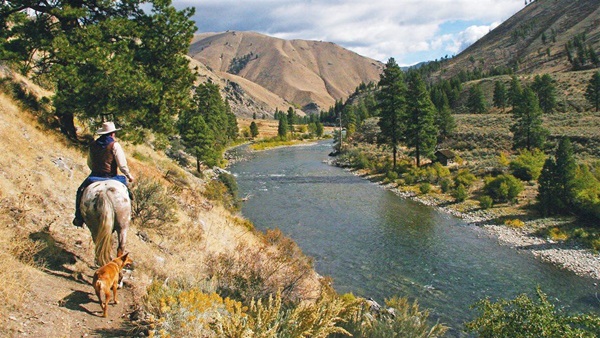Reach hard-to-reach places in your airplane
8 destinations for adventurous pilots
You can’t take a major airline to see the swimming pigs in Staniel Cay in the Bahamas, or to see the natural hot springs at a remote corner of Death Valley National Park. With your pilot certificate and some preflight planning, however, you can enjoy the hidden treasures of out-of-the-way places that are hard to reach by other means.
Island, desert, and backcountry destinations are within reach for pilots. Planning a trip could give you an opportunity to train for a new kind of flying or expand your aviation knowledge, so consider where your pilot certificate might take you.
1. Bahamas Out Islands
Even the pigs in the Bahamas lounge on sandy beaches and swim in turquoise waters. Private pilots can witness these swimming pigs firsthand by touching down in Staniel Cay in the Exumas and renting a small boat to an uninhabited cay off the main island. The Bahamas, not far off the coast of Florida, rewards a pilot’s foray into international flying with relaxing beaches and warm sun. Brush up on over-water and international flying before you set your course to the islands; flying with a group, as described in the February 2015 issue of AOPA Pilot, may boost your confidence and build camaraderie into your trip.
2. Tangier Island
But you don’t have to cross international borders to take your airplane to the islands. Tangier Island in the Chesapeake Bay off the coast of Virginia is accessible only by boat or airplane, and residents still speak with an accent reminiscent of early settlers. Pilots flying in can enjoy Chesapeake Bay crab cakes or rent a bike or golf cart to explore the community’s streets.
3. Mackinac Island
Motorized ground travel on Michigan‘s Mackinac Island is prohibited, so if you fly in to its paved runway, plan to walk, bike, or take a horse-drawn carriage where you need to go. You’ll find hotels, restaurants, and more, including Fort Mackinac, founded during the American Revolution.
Other popular island destinations like the Florida Keys, the San Juan Islands in the Northwest, and Put-in-Bay in Lake Erie attract visitors by air and water. California pilots can fly 26 miles from Los Angeles to dine at the Airport in the Sky and enjoy other attractions at Catalina Island; watch this AOPA Live video about landing at the unusual airport.
4. Denali
At 20,310 feet, Denali towers over Denali National Park and Reserve, described by the National Park Service as “six million acres of wild land, bisected by one ribbon of road.” Roads are scarce in many areas of Alaska, so leave civilization behind and explore the state’s landscape of glaciers, mountains, and tundra by air. Check out this article for tips about flying in Denali National Park.
5. Wild Alaska
Even a two-seat, VFR-only Cessna 150 can wind its way north of the Arctic circle with some advance planning, as demonstrated by a December 2014 AOPA Pilot article. Beyond sightseeing, small aircraft act as a lifeline to many isolated communities in the state; general aviation’s role in Alaskan communities got some time in the spotlight in the reality TV series Flying Wild Alaska.
6. Death Valley
If glacial climates aren’t your style, maybe you’d like the desert topography and roaming wild burros of Death Valley National Park in California. The backcountry airstrip Chicken Strip in a remote corner of the park is a short walk away from natural hot springs, but the “drive there is an arduous trek over rough dirt roads that take 3 or more hours to traverse,” according to the Recreational Aviation Foundation (RAF), which maintains the strip under a memorandum of understanding with the Park Service. AOPA and the RAF have urged the Park Service to keep the strip open as it considers planning alternatives for the area.
7. Russian Flat
When you leave the aircraft corral at Russian Flat airstrip in Montana, be sure to close the gates to keep cattle from wandering through. The airstrip, located high in the Lewis and Clark National Forest, opened to the public in 2010, a victory for passionate recreational aviators hoping to preserve and expand pilots’ access to remote and rugged land. Created through a partnership between the RAF, the Montana Pilots Association, and the Lewis and Clark National Forest, the 3,275-foot runway sits at an elevation of 6,400 feet.
At backcountry airstrips around the country, wildlife lovers can shut down the engine to the whisper of the wilderness for a day hike or camping trip. The RAF is on a mission to preserve these access points to forests, mountains, and unspoiled land, and has worked with AOPA on a number of issues, including helping protect seaplane access to Ross Lake, situated among mountains and glaciers in Washington state.
8. Negrito Airstrip
Elk, coyote, and turkey may be among the companions of visitors to New Mexico’s Negrito Airstrip in the Gila National Forest. At 8,000 feet, pilots would be wise to review the effects of density altitude before venturing to this field, and one should research a landing area for special precautions or considerations when flying to any remote or unimproved strip; the RAF provides pilot information for many backcountry airstrips on its website. The exhilaration of touching down in an area the general public rarely sees is worth the extra effort.
Find other ideas on where to fly and what to do with your pilot certificate in Aerial Adventures: 99 Ways to Fly AOPA’s first all-original e-book.





